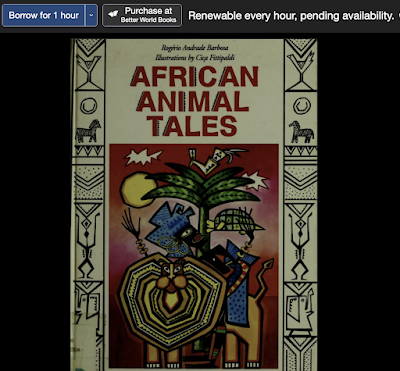And here we are, altready time for the final #AnansiBookClub book of February! You can see the February Calendar at the website, plus all the Book Club posts here at the blog. As usual, the final book of the month is an anthology, and this month it is African Animal Tales by Rogério Andrade Barbosa (translated by Feliz Guthrie) and illustrated by Ciça Fittipaldi:
Rogério Andrade Barbosa is a Brazilian author (more at Wikipedia and at his website), and he wrote this book based on his experiences living in Guinea-Bissau (formerly Portuguese Guinea) where he worked for the United Nations. In retelling these ten animal stories, Barbosa has created frametales that set up each storytelling scene, and the illustrations by Ciça Fittipaldi are inspired by the Yoruban art traditions of western Africa. I like all these stories so much that it is going to be hard to select just a few favorites to write about in this blog post! I'll begin with the first story, which is a chain tale, so you know I am excited about that! It's the Considerate Fly, which begins with the fly doing a good deed... that sets off a chain of unintended consequences for which the fly is then called to account before the king. You can see the characters in the chain in this illustration:
If you remember the Aardema book illustrated by the Dillons, you will recognize how this chain of events takes shape, but the fly is much nicer than that mosquito, who just starts things by gossiping, unlike the considerate fly: Why Mosquitoes Buzz in People's Ears.
The Serpent's Bride is another story that will be familiar: a reckless woman ends up marrying against her family's wishes... and her husband turns out to be a deadly serpent. Her brothers rescue her, which is a typical story pattern, but what's different about this story is that her brothers sound just like the cast of characters lifted from a dilemma tale: seer, carpenter, hunter, and thief. All their skills are needed to rescue their sister from the serpent. In a dilemma tale, there would then be a debate about which of the suitors (not brother) most deserves to marry the rescued woman, but since these are brothers and this is not a dilemma tale about suitors, the story just ends happily ever after! In a sense she marries the four brothers because she vows never to fall in love again and instead spends her life happily taking care of her brothers "because they truly loved her and cared about what happened to her." And yes, the serpent turns out to have many heads, as you can see in the illustration: eeeek!
I was also excited to find this story about the honeyguide bird and the bee; the explanation of just why the honeyguide bird, here called the "casolo" bird, is one of my favorite folktale topics, and this is a great story involving the bee and the bird caring for their young ones, following the advice of a traditional medicine-doctor: The Casolo Bird and the Bee. Here you can see the doctor and the bird and the bee who have come for consultations:
Another animal aetiology story that I really liked was Why Dogs Sniff Each Other. It's about two rival dog-kings, and one of the dog-kings falls in love with the sister of the other dog-king. Here is the dog pleading his case, asking the other dog-king to let him marry his sister:
Things do not go well, with no happily ever after. What is really intriguing to me about this story is how much it resembles an Aesopic fable about why dogs sniff each other's butts. No, Aesop does not have this delightful set-up of the dog-king in love, but there is still enough in common between the two stories that it seems certain that two storytellers, somehow somewhere, met up, traded stories, and so we have perfumed dogs in both an African story and an ancient Roman story too! We'll never know where the story started, but it ended up on both continents, and it's fun to read in either version. Here's the story from Aesop if you are curious: The Embassy of the Dogs.
There are several trickster Tortoise stories in this book, and it includes one of my favorites, when Tortoise "haunts" the market in order to raid the market when everyone runs away in fear: The Cunning of the Tortoise. It has some other great folktale elements too, like the magical music and also the revenge that Tortoise gets on her accuser. Here's Tortoise playing the music that makes all the animals dance:
For a final update this week, I wanted to share this great animal story which explains why birds scratch the ground and why roosters crow in the morning. Yes, it's a story about birds, with the main characters being foolish Hawk and his uncle Eagle, but it's also a story about Sun and Moon: The Hawk and the Eagle. Here's the illustration showing Moon:
So, I hope you will take a few minutes to explore the book for yourself: so many good stories, and some wonderful artwork also! Enjoy!








No comments:
Post a Comment
Comments are limited to Google accounts. You can also email me at laurakgibbs@gmail.com or find me at Twitter, @OnlineCrsLady.